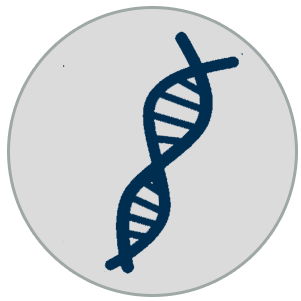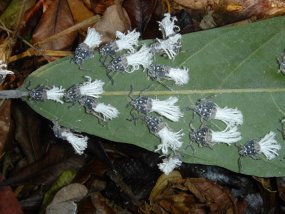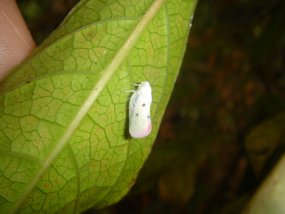 |
|                 |    | |||||
| | ||||||||



General Biology, Ecology and behaviour Interactions of planthoppers with host plants are essential as plants are used not only as sources of food but also as oviposition and mating sites, as shelter and as mean to communicate.
As shelter, host plants secure protection against predators (Spiders, phalangids, Heteroptera Miridae, Nabidae, Veliidae and Mesoveliidae, Coleoptera Coccinellidae and Staphylinidae (Döbel & Denno, 1994), Egg parasitoids (Hymenoptera Mymaridae and Trichogrammatidae) or nymphs and adults parasitoids, Hymenoptera Dryinidae, Diptera Pipunculidae, Strepsiptera (Cronin & Strong, 1994)). But also, host plants provide the tool for planthopper communication. Acoustic signals are transmitted by the substrate on which the insects are moving by a rhythmic and specific drumming of the abdomen. Planthoppers seem only concerned by a close range communication between insects on the same plant or on a group of plants whose foliage is in physical contact. Longer-range communication may not exist (Claridge & Vrijer, 1994). Communication in planthoppers directs the reproductive behaviour.
Planthoppers are generally univoltine (but many tettigometrids, cixiids, delphacids, are bi- or trivoltine). Eggs are laid separately or in groups in, on, or close to the plant (Cobben, 1965). They may be protected by waxy secretions, as in cixiids and some fulgorids, or surrounded with earth (egg case) in some issids (Boulard, 1987). Nymphs of cixiids, kinnarids and hypochthonellids are subterranean, whereas those of achilids and derbids live under bark. Some subsocial systems are known, particularly in tettigometrids, which are then most often ant-attended (Bourgoin, 1997).
Association of planthoppers with their host-plant show strong disparities according to the groups. For instance nymphs of Achilidae and Derbidae are linked to fungi. In Meenoplidae, about 80% of the adults are associated with monocots, whereas 80% of the adults of Fulgoridae and Dictyopharidae are associated with dicots (Wilson et al., 1994). The book of Denno and Perfect (1994) is an important contribution to Fulgoromorpha ecology and management.
As Fulgoromorpha are phytophagous insects, they appear unlikely candidates for a permanent life underground. However, more than 60 species distributed into 5 families are already known to be cavernicolous. All cavernicolous planthopers species belong to taxa which immature stages live close to or within the soil. The habits of these nymphs associated to soil environment seem to be a preadaptation to the cavernicolous life (Hoch, 2002). Many cavernicolous species of Fulgoromorpha display particular reductive or specialized morphological trends and behaviours. Reviews on cavernicolous Fulgoromorpha were published by Hoch (1994, 2002).
An important study about life strategies (host specificity, dispersal, life cycles, ... ) of Fulgoromorpha from Germany was recently published (Nickel, 2003).
Economy: Planthoppers as pests
Planthopper's biogeography Fulgoromorpha are distributed in all parts of the world but mainly in the tropics, with some species adapted to the deserts and dry areas or even north of the Arctic Circle in Alaska. However this biogeographical diversity is unequal for all the families. For instance, the Tettigometridae are absent from the Nearctic, Neotropical and Australian regions, the Meenoplidae are absent from the New World and nine families (Acanaloniidae, Achilidae, Achilixiidae, Eurybrachidae, Fulgoridae, Gengidae, Hypothnonellidae, Kinnaridae and Nogodinidae) are absent (or with few species) from the Palearctic area. From an historical perspective, biogeograpical scenarios in the Australasian area have been provided for the Lophopidae by Soulier-Perkins (1997, 2000).



Morphological characteristics Including about 14 000 described species divided in 30 families, planthoppers are generally small insects, varying in size from 3 to 15 mm. Nevertheless, some species of the family Fulgoridae have a body length of about 10 cm and a wingspread of about 14,5 cm. Within the Hemiptera, Fulgoromorpha are easily recognised by the presence of tegulae on the mesothorax, by the pedicel of antenna enlarged, often bulbous and bearing some enlarged placoid sensilla and a particular sensory organ, by relatively elongate midcoxae whose bases are widely separated.
A comprehensive account of Fulgoromorpha morphology can be found in papers by O'Brien & Wilson (1985) and by Carver et al. (1991). More particularly head capsule has been studied by Bourgoin (1986) and their special antennal sensilla by Bourgoin et Deiss (1994); wings and nervation by Fennah(1944), Scherbakov (1981, 1982, 1983), Dworakowska (1988), Bourgoin (1997); male genitalia by Fennah (1945), Bourgoin & Huang (1990); female genitalia by Bourgoin (1993); nymphal characteristics by Yang & Yeh (1994) and Emeljanov (2001).


Fulgoromorpha phylogeny Monophyly of Fulgoromorpha
Monophyly of the clade is attested by morphological and by molecular evidence as well. Molecular phylogeny based on 18S rDNA nucleotide sequences show strong support for a monophyletic Fulgoromorpha (Campbell & al, 1994, 1995, Sorensen & al, 1995, von Dohlen & al., 1995, Bourgoin & al., 1997, Bourgoin & Campbell, 2002). From a morphological perspective, monophyly of Fulgoromorpha is also well supported by several autapomorphies. Most notably some unique morphological characters strongly support this view: the sensory plate organs of the pedicel, the intracephalic position of anterior invaginations of the pretentorium and the presence of Bourgoin's organ in the antennal pedicel. However, Yang & Fang (1993) using distances based on a phenetic analysis placed the Tettigometridae family in a sister position to Cicadomorpha Membracoidea.
Fossil data have recently been tentatively incorporated into a phylogeny of the order Hemiptera based on molecular and morphological interpretations (Bourgoin & Campbell, 2002). A catalogue of all fossil Fulgoromorpha with notes on Hemiptera classification has recently been published (Szwedo & al., 2004).
Family relationships
Various interpretations based on morphological characters have never fully agreed on the phylogenetic position of Fulgoromorpha families and particularly with the place of the family Tettigometridae. Two main positions have been invoked. The classical viewpoint, which places Tettigometridae as the sister-group of all other Fulgoromorpha, was initially proposed by Muir (1923). He was followed by Asche (1988), who presented an important discussion on this subject. Emeljanov (1990) also placed the Tettigometridae as the sister group of all other fulgoromorphan families and proposed a complete and resolved cladogram of the Fulgoromorpha. The second viewpoint on the affiliation of tettigometrids within Fulgoromorpha was also alluded to by Muir (1930) but without clarification. He considered that Tettigometridae might be a more derived lineage closely affiliated with tropiduchoid families. Such point of view gained recent support with morphological and molecular studies (Bourgoin & al., 1997).
For the other families authors agree more or less for some groupings. However it must be mentioned that only few families have been shown to be monophyletic and very probably all these hypotheses should be modified in the future. A key to Lophopidae genera and their phylogeny was provided by Soulier (1998, 2001).
Selected and Cited References
- Asche, M., 1985. - Zur Phylogenie der Delphacidae Leach, 1815 (Homoptera, Cicadina, Fulgoromorpha). Marburger Entomologische Publikationen, 2: 1-910.
- Asche, M., 1988. - Preliminary thoughts on the phylogeny of Fulgoromorpha (Homoptera, Auchenorrhyncha). Proceedings. 6th Auchenorrhyncha Meeting, Turin, Italy, 7-11 sept. 1987, pp. 47-53.
- Asche, M., 1990. - Vizcayinae, a new subfamily of Delphacidae with revision of Vizcaya Muir (Homoptera: Fulgoroidea) - a significant phylogenetic link. Bishop Museum Occasional Papers, 30: 154-187.
- Boulard, M., 1987. - Contribution à l'étude des Issidae. L'oothèque terreuse des "Hysteropterum", un problème évolutif. Bull. Soc. Entomol. Fr., 92(1-2): 1-18.
- Bourgoin, Th., 1986. - Morphologie imaginale du tentorium des Hemiptera Fulgoromorpha. Int. J. Insect. Morphol. Embryol., 15(4): 237-252.
- Bourgoin, Th. & J. Huang, 1990. - Morphologie comparée des genitalia males des Trypetimorphini et remarques phylogénétiques (Hemiptera Fulgoromorpha : Tropiduchidae). Ann. Soc. Entomol. Fr., (N.S.), 26(4): 555-564.
- Bourgoin, Th., 1993. - Female genitalia in Fulgoromorpha (Insecta, Hemiptera): morphological and phylogenetical data. Ann. Soc. Entomol. Fr., (N.S.), 29(3): 225-244.
- Bourgoin, Th. & V. Deiss, 1994. - Sensory plate organs of the antenna in the Meenoplidae-Kinnaridae group (Hemiptera : Fulgoromorpha). Int. J. Insect. Morphol. Embryol., 23(2): 159-168.
- Bourgoin Th., 1997. - The Meenoplidae (Hemiptera, Fulgoromorpha) of New Caledonia, with a revision of the genus Eponisia Matsumura, 1914, and new morphological data on forewing venation and wax plate areas. In L. Matile, J. Najt & S. Tillier (eds), Zoologia Neocaledonica, 3. Mem. Mus. nat. Hist. nat., (Zoologie): 197-250.
- Bourgoin, Th., 1997. - Habitat and ant-attendance in Hemiptera : a phylogenetic test with emphasis on trophobiosis in Fulgoromorpha. In Grandcolas, P. (ed.), The origin of biodiversity in Insects : phylogenetics tests of evolutionary scenarios. Mem. Mus. nat. Hist. nat., 173: 109-124.
- Bourgoin Th., Steffen-Campbell, J.D. & B.C. Campbell, 1997. - Molecular phylogeny of Fulgoromorpha (Insecta, Hemiptera, Archaeorrhyncha). The enigmatic Tettigometridae : evolutionary affiliations and historical biogeography. Cladistics, 13(3): 207-224.
- Bourgoin Th. & B.C. Campbell, 2002. - Inferring a phylogeny for Hemiptera: falling into the autapomorphic trap. Denisia 4: 67-81.
- Campbell, B.C., Steffen-Campbell, J.D. & Gill, R. 1994. - Evolutionary origin of whiteflies (Hemiptera: Sternorrhyncha: Aleyrodidae) inferred from rDNA sequences. Insect Molecular Biology, 3(2): 73-88.
- Campbell, B.C., Steffen-Campbell, J.D., Sorensen, J. T. & R. Gill, 1995. - Paraphyly of Homoptera and Auchenorrhyncha inferred from 18S rDNA nucleotide sequences. Syst. Entomol., 20: 175-194.
- Carver, M., Ross, G.F. & T.E., Woodward, 1991. - Hemiptera (bugs, leafhoppers, cicada, aphids, scale insects, etc.) pp 429-509. In Naumann, I.D., Crane, P.B., Lawrence, J.F., Neilsen, E.S., Spradbery, J.P., Taylor, R.W., Whitten, M.J. & M.J. Littlejohn (eds). The Insects of Australia, a textbook for students and research workers. Vol. 1 (2nd ed). Melbourne Univ. Press, Melbourne, Australia.
- Claridge, M.F. & P.W.F. de Vrijer, 1994. - Reproductive behavior : the role of acoustic signals in species recognition and speciation. In R.F. Denno & T.J. Perfect Edts, Planthoppers, their Ecology and Management, pp. 216-233.
- Cobben, R.H., 1965. - Das aero-mikropilare System der Homoptereneier und Evolutionstrends bei Zikadeneiern (Hom. Auchenorhyncha). Zool. Beitr., 11 1-2.
- Cronin, J.T. & D.R. Strong, 1994. - Parasitoid interactions and their contribution to the stabilization of Auchenorrhyncha populations. In R.F. Denno & T.J. Perfect Edts, Planthoppers, their Ecology and Management, pp. 400-428.
- Cryan, J.R. & J.M. Urban. 2012. - Higher-level phylogeny of the insect order Hemiptera: Is Auchenorrhyncha really paraphyletic? Systematic Entomology 37: 7-21.
- Denno, R.F. & T.J. Perfect, 1994. - Planthoppers, their Ecology and Management. Chapman & Hall, 799 pp.
- Döbel, H.G. & R.F. Denno, 1994. - Predator-planthopper interactions. In R.F. Denno & T.J. Perfect Edts, Planthoppers, their Ecology and Management, pp. 325-399.
- Emeljanov, A.F., 1990. - An attempt of construction of phylogenetic tree of the planthoppers (Homoptera, Cicadina). Entomologicheskoye Obozreniye, 69: 353-356.
- Emeljanov, A.F., 2001. - Larval characters and their ontogenetic development in Fulgoroidea (Homoptera, Cicadina). Zoosystematica Rossica 9 (1): 101-121.
- Herdt, R.W., 1987. - Equity considerations in setting priorities for third world rice biotechnology research. Developments: seeds of change, 4: 19-24.
- Hoch, H., 1994. - Homoptera (Auchenorrhyncha Fulgoroidea). In C. Juberthie & V. Decu Edt., Encyclopedia Biospeleogica, Moulis - Bucarest, Soc. Biospéologie Pub., 1: 313-325.
- Hoch, H., 2002. - Hidden from the light of day: planthoppers in subterranean habitats (Hemiptera: Auchenorrhyncha: Fulgoromorpha). Denisia 4: 139-146.
- Muir, F., 1923. - On the classification of the Fulgoroidea (Homoptera). Proc. Hawaiian Ent. Soc., 5(2) : 205-247.
- Muir, F., 1930. - On the classification of the Fulgoroidea (Homoptera). Ann. Mag. Nat. Hist., 10(6): 461-478.
- Nickel, H. 2003. The leafhoppers and planthoppers of Germany (Hemiptera, Auchenorrhyncha): Patterns and strategies in a highly diverse group of phytophagous insects. Pensoft publishers, 460 pp.
- O'Brien, L. & S. Wilson, 1985. - Planthopper systematics and external morphology. In Nault, L. R. and Rodrigues, J.G., The Leafhoppers and Planthoppers, N.Y., Wiley and Sons, pp. 61-102.
- Sorensen, J.T., Campbell, B.C., Gill, R.J. & J.D. Steffen-Campbell, 1995. - Non-monophyly of Auchenorrhyncha ("Homoptera"), based upon 18S rDNA phylogeny : eco-evolutionary and cladistic implications within pre-Heteropterodea Hemiptera (s.l.) and a proposal for new monophyletic suborders. Pan-Pacific Entomol., 71(1): 31-60.
- Soulier-Perkins, A., 1997. - Systématique phylogenetique et test d'hypotheses biogeographiques chez les Lophopidae (Hemiptera, Fulgoromorpha). I et II., These de Doctorat, Museum nat. Hist. nat., 128 + 165 pp.
- Soulier-Perkins, A., 1998. The Lophopidae (Hemiptera : Fulgoromorpha): Description of three new genera and key to the genera of the family. Eur. J. Entomol. 95: 599-618.
- Soulier-Perkins A., 2000. A phylogenetic and geotectonic scenario to explain the biogeography of the Lophopidae (Hemiptera, Fulgoromorpha). Palaeogeography, Palaeoclimatology, Palaeoecology 160, 239-254.
- Soulier-Perkins A., 2001. The phylogeny of the Lophopidae and the impact of sexual selection and coevolutionary sexual conflict. Cladistics, 17, 56-78.
- Szwedo, J., Bourgoin, Th. & F. Lefebvre. 2004. Fossil Planthoppers (Hemiptera: Fulgoromorpha) of the world: An annotated catalogue with notes on Hemiptera classification. Studio 1, 199 pp.
- Urban, J.M., C.R. Bartlett & J.R. Cryan. 2010. - Evolution of Delphacidae (Hemiptera: Fulgoroidea): Combined-evidence phylogenetics reveals importance of grass host shifts. Systematic Entomology, 35: 678-691.
- Urban, J.M. & J.R. Cryan. 2007. - Evolution of the planthoppers (Insecta: Hemiptera: Fulgoroidea). Molecular Phylogenetics and Evolution, 42: 556-572.
- Urban, J.M. & J.R. Cryan. 2009. - Entomologically famous, evolutionarily unexplored: The first phylogeny of the lanternfly family Fulgoridae (Insecta: Hemiptera:Fulgoroidea). Molecular Phylogenetics and Evolution, 50: 471-484.
- Von Dohlen, C. & N.A. Moran, 1995. - Molecular phylogeny of the Homoptera : a paraphyletic taxon. J. Mol. Evol., 41: 211-223.
- Wilson, M.R. & M.F. Claridge, 1991. - Handbook for the identification of leafoppers and planthoppers of rice. C.A.B. International, 142 pp.
- Wilson, S.W., Mitter, C., Denno, R.F. & M.R. Wilson, 1994. - Evolutionary patterns of hostplant use by delphacid planthoppers and their relatives. In R.F. Denno & T.J. Perfect editors, Planthoppers : their Ecology and Management, pp. 7-113.
- Wilson S.W. & O'Brien L.B., 1987. - A survey of planthoppers pests of economically important plants (Homoptera: Fulgoroidea). In Proceedings of 2nd International Workshop on Leafhoppers and Planthoppers of Economic importance, Wilson, M.R. & Nault, L.R., 28th July-1st August 1986, Brigham Young University, Provo, Utah, USA, London, CAB Int. Inst. Ent., pp. 343-360.
- Yang, C.-T. & S.-J. Fang, 1993. - Phylogeny of Fulgoromorpha nymphs, first results. Proceedings. 8th Auchenorrhyncha Congress, Delphi, Greece, 9-13 aug. 1993, pp. 25-26.
- Yang, C.-T. & W.-B. Yeh, 1994. - Nymphs of Fulgoroidea (Homoptera: Auchenorrhyncha) with description of two new species and notes on adults of Dictyopharidae. Chin. J. Entomol., Special Pub., 8: 1-189.
|
|
|
|
| |||

